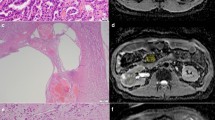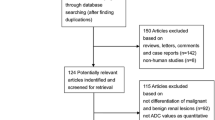Abstract
Objectives
To evaluate the diffusion characteristics of inflammatory renal lesions and assess whether apparent diffusion coefficient (ADC) values can distinguish them from renal-cell carcinomas (RCCs).
Methods
Eighty-eight patients underwent multidetector computed tomography (MDCT), magnetic resonance imaging (MRI) and diffusion-weighted (DW) MRI (at b values of 0 and 500 s/mm2) for characterisation of focal renal lesions. On retrospective evaluation, 15 patients had 20 inflammatory lesions and 33 patients had 36 RCCs. DW images were compared and receiver operating characteristic (ROC) curves were drawn to establish cut-off ADC values.
Results
All inflammatory lesions and 91.7% of RCCs showed restricted diffusion. DW images showed markedly restricted diffusion in fluid intensity areas of abscesses, whereas RCCs showed free diffusion in their cystic portions. Quantitatively, both abscesses and RCCs showed ADC values significantly lower than normal renal parenchyma [1.12 and 1.56 respectively vs 2.34 (× 10-3 mm2/s) for normal kidney] (P < 0.0001 for both) and significantly different from each other (P < 0.0001). ROC analysis in differentiating inflammatory lesions and RCC revealed high sensitivity (100%) and specificity (78.1%) for cut-off ADC value of 1.41 (× 10-3 mm2/s).
Conclusions
Both abscess and RCC showed restricted diffusion, the former did so to a greater extent, distinctly in fluid components. Thus, ADC values provide an additional paradigm for characterisation of indeterminate renal lesions.
Key Points
• Both RCCs and inflammatory lesions show restricted diffusion on MRI.
• Diffusion restriction is not specific for malignancy; rather, inflammatory lesions show greater restriction.
• Fluid components of abscesses show marked diffusion restriction; cystic components of RCC show free diffusion.
• ADC values and diffusion restriction pattern provide an additional paradigm for indeterminate lesions.
• DW MRI may obviate the need of intravenous contrast in abscesses, which is useful in patients with renal dysfunction.






Similar content being viewed by others
References
Kutikov A, Fossett LK, Ramchandani P et al (2006) Incidence of benign pathologic findings at partial nephrectomy for solitary renal mass presumed to be renal cell carcinoma on preoperative imaging. Urology 68:737–740
Prasad SR, Dalrymple NC, Surabhi VR (2008) Cross-sectional imaging evaluation of renal masses. Radiol Clin North Am 46:95–111, vi-vii
Israel GM, Bosniak MA (2005) How I do it: evaluating renal masses. Radiology 236:441–450
Bhatt S, MacLennan G, Dogra V (2007) Renal pseudotumours. AJR Am J Roentgenol 188:1380–1387
Pickhardt PJ, Lonergan GJ, Davis CF, Kashitani N, Wagner BJ (2000) Infiltrative renal lesions: radiologic-pathologic correlation. Radiographics 20:215–243
Israel GM, Bosniak MA (2005) An update of the Bosniak renal cyst classification system. Urology 66:484–488
Whalley PJ, Cunningham FG, Martin FG (1975) Transient renal dysfunction associated with acute pyelonephritis of pregnancy. Obstet Gynecol 46:174–177
Saremi F, Knoll AN, Bendavid OJ, Schultze-Haakh H, Narula N, Sarlati F (2009) Characterization of genitourinary lesions with diffusion-weighted imaging. Radiographics 29:1295–1317
Ebisu T, Tanaka C, Umeda M et al (1996) Discrimination of brain abscess from necrotic or cystic tumours by diffusion-weighted echo planar imaging. Magn Reson Imaging 14:1113–1116
Kim YJ, Chang KH, Song IC et al (1998) Brain abscess and necrotic or cystic brain tumour: discrimination with signal intensity on diffusion-weighted MR imaging. AJR Am J Roentgenol 171:1487–1490
Noguchi K, Watanabe N, Nagayoshi T et al (1999) Role of diffusion-weighted echo-planar MRI in distinguishing between brain abscess and tumour: a preliminary report. Neuroradiology 41:171–174
Desprechins B, Stadnik T, Koerts G, Shabana W, Breucq C, Osteaux M (1999) Use of diffusion-weighted MR imaging in differential diagnosis between intracerebral necrotic tumours and cerebral abscesses. AJNR Am J Neuroradiol 20:1252–1257
Lai PH, Ho JT, Chen WL et al (2002) Brain abscess and necrotic brain tumour: discrimination with proton MR spectroscopy and diffusion-weighted imaging. AJNR Am J Neuroradiol 23:1369–1377
Squillaci E, Manenti G, Di Stefano F, Miano R, Strigari L, Simonetti G (2004) Diffusion weighted MR imaging in the evaluation of renal tumours. J Exp Clin Cancer Res 23:39–45
Cova M, Squillaci E, Stacul F et al (2004) Diffusion weighted MRI in the evaluation of renal lesions: preliminary results. Br J Radiol 77:851–857
Yoshikawa T, Kawamitsu H, Mitchell DG et al (2006) ADC measurement of abdominal organs and lesions using parallel imaging technique. AJR Am J Roentgenol 187:1521–1530
Zhang J, Tehrani YM, Wang L, Ishill NM, Schwartz LH, Hricak H (2008) Renal masses: characterization with diffusion-weighted MR imaging—a preliminary experience. Radiology 247:458–464
Taouli B, Thakur R, Mannelli L et al (2009) Renal lesions: characterization with diffusion-weighted imaging versus contrast-enhanced MR imaging. Radiology 251:398–407
Kilickesmez O, Inci E, Atilla S et al (2009) Diffusion-weighted imaging of the renal and adrenal lesions. J Comput Assist Tomography 33:828–833
Sandrasegaran K, Sundaram CP, Ramaswamy R et al (2010) Usefulness of diffusion-weighted imaging in the evaluation of renal masses. AJR Am J Roentgenol 194:438–445
Thoeny HC, De Keyzer F, Oyen RH, Peeters RR (2005) Diffusion- weighted MR imaging of kidneys in healthy volunteers and patients with parenchymal diseases- initial experience. Radiology 235:911–917
Chan JHM, Tsui EYK, Luk SH et al (2001) MR diffusion-weighted imaging of kidney- Differentiation between hydronephrosis and pyonephrosis. Clinical Imaging 25:110–113
Verswijvel G, Vandecaveye V, Gelin G et al (2002) Diffusion-weighted MR imaging in the evaluation of renal infection: preliminary results. JBR-BTR 85:100–103
Goyal A, Gadodia A, Sharma R (2010) Xanthogranulomatous pyelonephritis: an uncommon pediatric renal mass. Pediatr Radiol 40:1962–1963
Author information
Authors and Affiliations
Corresponding author
Rights and permissions
About this article
Cite this article
Goyal, A., Sharma, R., Bhalla, A.S. et al. Diffusion-weighted MRI in inflammatory renal lesions: all that glitters is not RCC!. Eur Radiol 23, 272–279 (2013). https://doi.org/10.1007/s00330-012-2577-0
Received:
Revised:
Accepted:
Published:
Issue Date:
DOI: https://doi.org/10.1007/s00330-012-2577-0




